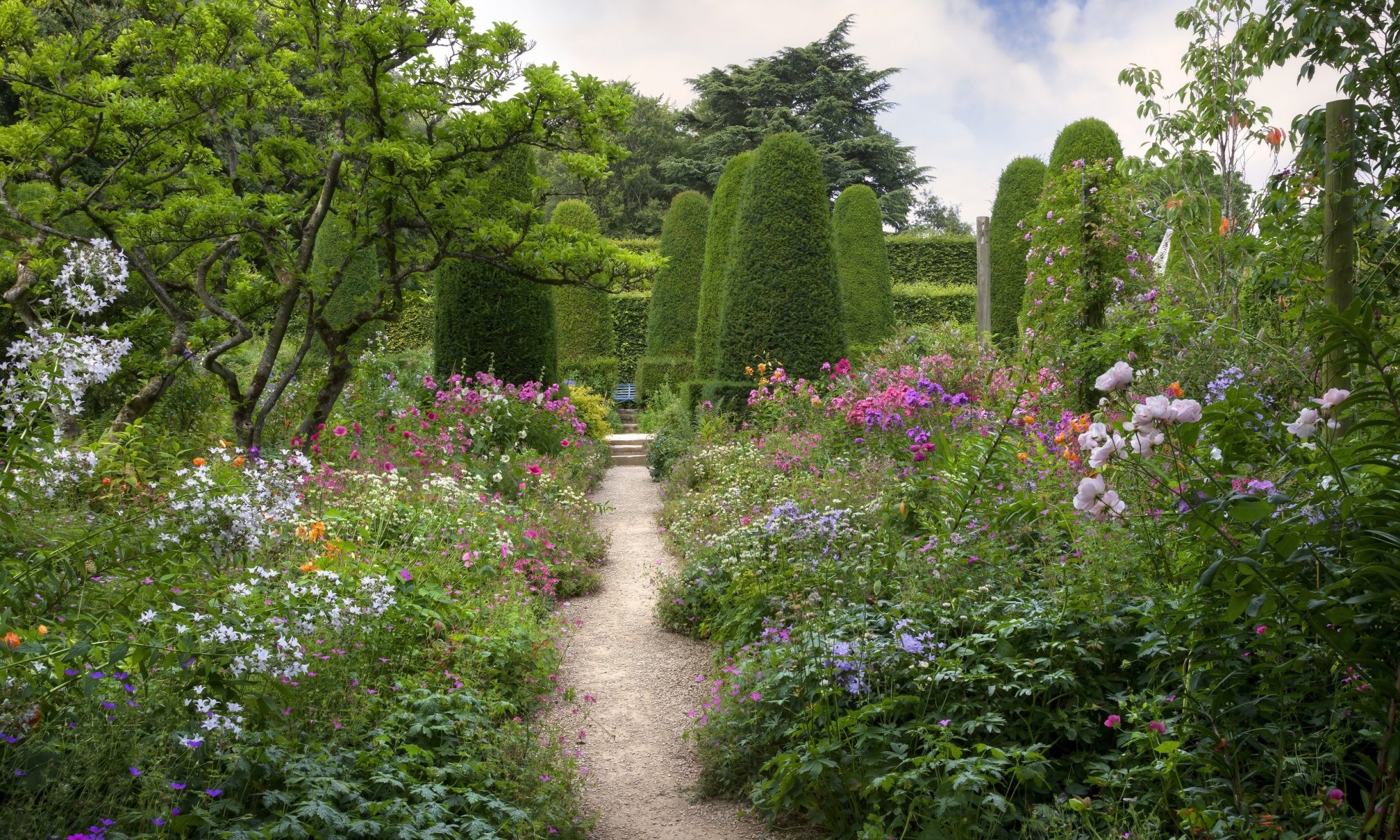Jo Arnell takes a look at the (frustratingly) skilled art of topiary
There’s something soothingly barbaric about topiary. A tightly pruned tree growing exactly how we want it to grow – forced into submission and yet still happy enough to have green leaves, as alive as a well-groomed dog show poodle – is a sign that we are in control. All is calm. It would be a freak of nature if a tree grew of its own accord to look like a squirrel or a peacock, but somehow the thought of making it grow into a shape of our choosing – even if all we can manage is a cone or a lollipop – is almost irresistible, and the results can be highly ornamental and attractive.
What I love about topiary is the contrast it makes with the rest of the plants – a pair of well trained box or bay trees either side of a front door looks smart, but tightly clipped and dense shapes out in the garden mingling with the more unruly natural forms can be really effective – they add backbone and focal points, like living sculptures in the landscape, bringing height, structure and form all year round. In the winter, when everything else has turned skeletal, or rotted away, and in the sparkly light of a frosty morning, topiary becomes a truly magical sight.
The plants to choose
Some shrubs and trees grow tidily, but don’t like to be pruned (I’m thinking of my nemesis the Daphne, that seems to wither under my gaze, let alone the clippers) and those that are prone to disease – that gets in through cut surfaces. In the main, any shrub or tree that will make a hedge can be topiariarised. Evergreens are best, as they will provide year round foliage, but occasionally deciduous plants are used, especially if they have flowers – dwarf Lilac makes a pretty and fragrant little tree, colourful foliage – Salix ‘Flamingo’, or the autumnal tints of Beech or Hornbeam. The most familiar plants would be Box or Yew, and these are traditional, hardy and amenable, but Box is under threat from blight and caterpillars, and Yew can be expensive and slow to establish. Ilex crenata is a very good substitute for Box with similar miniature leaves. Some conifers can also be clipped, but make sure you get a variety that will grow back from the old wood. Larger leaved evergreens, like Viburnum tinus, Holly, Bay and Photinia can be grown as standards. You can even use trailing plants like Ivy, but these should be trained over a wired frame, rather than being trimmed back to a shape. Some small leaved evergreens and conifers are particularly effective when cloud pruned – a style of pruning that originated in Japan that results in artful bare stems with clipped leaves just at the ends – in cloud shapes.
The tools to use
There are electric trimmers around that are not much bigger than shavers, which are fine for basic shapes and mini hedges, but a good quality pair of topiary clippers (sheep shears are great) will be an essential piece of kit for more detailed and intricate trimming. You can use secateurs, but they are not as effective for the quick and repetitive clipping action that will result in a more sculpted and neat shape. Whatever tools you use it is essential to keep them really sharp and well-oiled, and, if you are clipping more than one plant in a session, to clean them thoroughly before you move onto the next victim. Infections and diseases are easily spread though cut surfaces and ragged cuts cause die-back and look unsightly.
How to do it
If you are just starting out, it’s a good idea to begin with geometric shapes like balls, spirals or pyramids. You can use formers – wire frames that are placed over the plant that you trim to, or if the shape is straight or diagonal, you can use a string line to cut to. This is very useful for hedges and for triangular shapes that need to be symmetrical. In time you will become practised and once the shape is established, be able to cut to the outline each time.
The more regularly you cut topiary, the denser the leaves will look and the stronger the outline. If you want to keep your shapes looking crisp and sharp, or are using a faster growing plant, you will need to cut more often, but slow growing shrubs like box and yew can sometimes be kept in shape with just one summer cut – which is what makes them popular, especially when there is a lot of it to snip. Evergreens are generally trimmed in the summer, as this gives them time to recover before the winter weather – and the damaging frosts that would ravage tender new growth.
More complicated shapes will take practice and an understanding of how the plant grows. It helps to have a good eye too. I went on a course once and the Chelsea gold medallist who ran it was a hairdresser before he turned his scissors to plants. It turns out that hairdressers are great at styling plants. There is a lot of stepping back required, surveying and imagining, working out what shape is going to be made by the absence of a twig before that twig is removed – and remembering that wherever you make the cut, this is where the new growth will start from (but there’s no discussing holidays or dealing with unreasonable client expectations).
Practice makes perfect – as does experience and making mistakes. You will learn by doing – and by cutting. The great thing is that your elephant’s trunk, or whatever it is you are shaping, will grow back if you accidentally snip it off, even if you have to wait a while for that to happen.
Caring for topiary specimens
No plants choose to be pruned – tiny pairs of secateurs don’t grow out of the ground as the shoots emerge. Plants are able to regrow once they’ve been attacked or cut, because they can’t run away fast enough from whatever is attacking them.. Recovering from a ravaging is how a plant manages to survive – and this is also how we can manipulate them to grow back in certain ways, but it comes at a cost. Plants make energy for growth through their leaves and constantly cutting the foliage back can weaken the overall plant, so it pays to look after your topiary specimen well. This means helping the plant to replenish nutrients lost – planting into good soil in the first place, fertilising appropriately in the spring, watching out for signs of pests and disease and keeping it adequately watered, especially if the plant is growing in a pot. Stressed plants never really thrive, so try to keep closely clipped plants in excellent health.
Where to see it
Topiary on a grand scale can look spectacular – a testament to gardeners’ skill, imagination and manipulation of plant material. It can be majestic, breathtakingly smart and formal, or whimsical and faintly comic, like the garden of a fairytale giant or the set of a Tim Burton film. While we might not be able to create such fantasies in our own spaces, there are several large gardens where you can visit and wander among looming evergreen shapes and living sculptures. Levens Hall in Cumbria is a wonderful place, home to the most magnificent and massive topiary, Clivedon in Buckinghamshire boasts peacocks and pyramids as well as an extensive parterre garden and a maze, no less. Closer to home in Northiam, East Sussex, Great Dixter’s huge yew hedges and topiary dominate the gardens and meadows like eccentric characters in a wonderland. Most public gardens are closed during the winter months, but any that do stay open and feature tightly clipped evergreens are much visited – on winter mornings especially – by photographers in search of frosted effects. These places can provide us with inspiration to tackle our much smaller projects and encourage us to experiment with gardening techniques – even if these are in the end limited to mere admiration without mimicry.
Jo’s 2023 garden design courses are now booking: 07923 969634 hornbrookmanor.co.uk
You may also like
In Shrubs We Trust
Jo Arnell pays attention to some often-overlooked garden stalwarts Shrubs are back. I’m not sure that they ever went away to be honest, but drifts of perennials and meadow plants have been stealing the limelight in recent years. Perhaps it’s...
Making Meadows
Jo Arnell takes a wander through wonderful wildflowers and marvellous meadows I have just come in from my field with a bag of Yellow Rattle seeds, having collected them for a friend to help her establish a meadow. It’s a...
Diorama & Rust
An enchanting and truly individual garden in Bethersden is opening this August in aid of Macmillian. Jo Arnell goes along for a special preview This month we are visiting a one-of-a-kind beautiful garden in Bethersden; an archetypal Kent cottage oozing...










